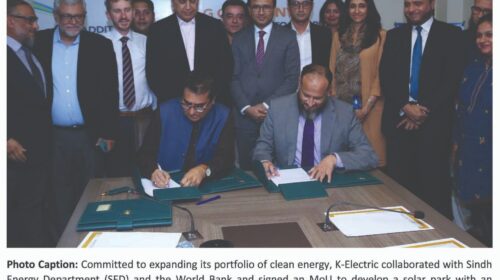December 10, Karachi: Committed to the aim to expand its portfolio of clean energy, KE has allied with Sindh Energy Department (SED) and the World Bank to develop a solar park with an aggregate capacity of 350 MW under the ambit of the ‘Sindh Solar Energy Project’ (SSEP). The objective of SSEP is to increase solar power generation and access to electricity in Sindh Province. The purpose of this tripartite arrangement – formalized today with the signing of a Memorandum of Understanding (MoU) – is to develop and implement sustainable, cost-effective, and competitive utility-scale IPPsin Karachi under a competitive bidding structure.
Through this collaboration, an additional 700 GWh of clean energy will be added to KE’s electricity supply mix that should offset carbon emissions by 300-350 kilotons per annum. This is in line with the Government of Pakistan’s aim, as stipulated in the Alternative and Renewable Energy (ARE) Policy 2019, of increasing the share of renewables (excluding hydel) as a share of the country’s power generation capacity to 30% by 2030.
The MoU was signed between Secretary, Energy Department, Government of Sindh, Abu Bakar Ahmed Madani, CEO K-Electric, Syed Moonis Abdullah Alvi, and World Bank Country Director for Pakistan, Najy Benhassine who joined via video from Islamabad.
This tri-partite collaboration is being supported by the World Bank through development financing to the Government of Sindh for the implementation of SSEP. SED will be responsible for conducting relevant project-related studies, implementation of the competitive bidding process, and construction of any public sector infrastructure that is required. The solar IPPs would be constructed and owned by competitively selected private sector developers. Once complete, the power from the project (s) would be inducted into KE’s grid via power off-take agreements, enhancing its ability to serve the current and evolving needs of its growing consumer base of 3.2 million.
Speaking at the occasion, the Sindh Minister for Energy, Imtiaz Ahmed Shaikh commented, “This project has been in the works for some time and is being achieved with close collaboration and support of the stakeholders. The Sindh Energy Department is committed to making a meaningful contribution in the effort towards Pakistan’s cleaner and greener energy future, and we hope to share our learnings and experience at the national and international level to expand the scale of the impact.”
CEO K-Electric Moonis Alvi also mentioned, “We appreciate the Sindh Energy Department and the World Bank for coming together on this historic event, which demonstrates our collective commitment towards the sustainable growth and future of Karachi and the Province of Sindh at large. At KE, environment and sustainability are integral parts of our strategy, focused on mitigating the impact of carbon and increasing KE’s footprint of clean energy. We follow Environment and Sustainability Management Systems (ESMS) to ensure our business activities have a minimal harmful impact on our surroundings. As the only vertically integrated power utility company in Karachi, it is of utmost importance for us to ensure the availability of clean, reliable, and low-cost electricity for our consumers which will promote economic growth for Pakistan.”
Joining remotely, Country Director for the World Bank Pakistan, Najy Benhassine said, “Transitioning to renewable energy offers Pakistan the potential to reduce its generation costs, diversify away from imported fossil fuels, and realize climate change, air pollution, and water conservation benefits. Sindh Province is key to increasing the share of renewable energy generation in Pakistan and developing new ways of providing electricity access. This engagement between the World Bank, K-Electric, and the Sindh Energy Department, under the auspices of the Sindh Solar Energy Project, could provide a replicable model for expanding renewable energy and access to electricity in Sindh Province and Pakistan.”
The inclusion of 350 MW solar power would result in the diversification of KE’s fuel mix and would increase the share of low-cost solar power generation in the system.





